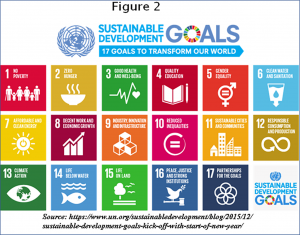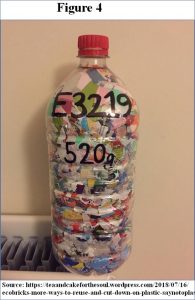We, the human race, have only planet Earth to call our own! This planet has passed through so many ages, viz., the Ice Age, the Stone Age, the Bronze Age, the Iron Age and now, we are in the Modern Age (see figure 1, Reference 1 & 2). However, there was never the strong urgency to preserve our planet as it exists now. Currently, there is a huge worry about the future changes in the environment, about the future particularly, the increasing level of temperature. This has happened due to multiple reasons including industrialization and deforestation that are leading to rising sea levels, typhoons, severe storms, floods, earthquakes, and many other disastrous natural events. The increasing environmental awareness has meant that United Nations along with the governments of several nations across the world have taken note of it and evolving policy to address it. This has led to the buzzword “sustainable development”.
According to the Sustainable Development Commission, UK, “Sustainable development is development that meets the needs of the present, without compromising the ability of future generations to meet their own needs.” (Reference 3). An important development to address this concern was the birth of the 17 Sustainable Development Goals by the United Nations (UNO) at its Conference on Sustainable Development held at Rio De Janeiro, Brazil in the year 2012. (Figure 2, Reference 4). These SDGs were evolved to replace the Millennium Development Goals (MDGs) which had been evolved to tackle the menace of global poverty. The development of the SDGs was targeted towards producing a set of universal goals that would meet the urgent environmental, political and economic challenges facing the world. The 17 SDGs were adopted under the 2030 Agenda for Sustainable Development to be implemented from January 1, 2016. In the presence of 193 Heads of State and other top leaders at a summit at UN Headquarters in New York in September 2015, the UN Secretary-General Ban Ki-moon had said, “The seventeen Sustainable Development Goals (SDGs) are our shared vision of humanity and a social contract between the world’s leaders and the people”.

Amongst the 17 SDGs, Goal number 6: CLEAN WATER AND SANITATION states “Ensure availability and sustainable management of water and sanitation for all”. In this respect, let me talk about a few unique initiatives done by our Resident Welfare Association (RWA) of the Society where I live.
As part of the discussion-based initiative in our management group, we sought to conserve water looking to the rising cost of procuring water as well as to avoid wastage. A few innovative ideas were evolved and implemented in the homes. Let me talk about two such ideas. The first of the idea is well known and entails use of RO wastewater (Figure 3, Reference 5). As per this idea, we asked each of the resident members to collect the wastewater coming out from the RO Water Filter systems installed in their kitchens and use the same for washing vegetables, flush-tanks in washroom, gardening purpose or in washing machines.

The second idea was really innovative. Not only does it address the extra water usage and thus its wastage, but also the menace of pollution caused by plastic waste. This was aimed at the water usage in the flush-tanks of the washrooms. As a first step, we asked the children and adults in the society not to throw away the plastic wrappers of whatever snack items they were eating, collect them and provide them to the society office. Along with that, they were also asked to provide old mineral water bottles of 1 liter which they were planning to throw away. Subsequently, the mineral water bottle was filled up with these plastic waste items post shredding the wrappers in small pieces. Once the bottle was fully packed, this bottle was then sealed and was placed in the flush-tanks. This ensured that a smaller amount of water would then be used for flushing purpose. Thus, while saving water, this initiative also helped us in reducing the pollutant caused by the plastic bottle as well as the plastic wrapper waste. Infact, this concept is called a “Eco brick” (Figure 4, reference 6) and awareness about it is low, but spreading across societies now.
A further initiative planned by the RWA is the installation of the waste Water Treatment Plant within the Society compound to treat the waste water and reuse it for gardening and, if feasible, rerouting the same to flush-tanks line in the washrooms. However, the same may entail allocation of scarce resources with the RWA.
As the above initiatives show it is quite feasible to save water and avoid pollution by thinking of small, but implementable simple and innovative ideas.
REFERENCES:
- Archaeosoup Productions, UK (2023, June 3). The Age of Stone, Bronze and Iron. https://archaeosoup.com/prehistory/
- Archaeosoup Productions, UK (2023, June 3). The Age of Stone, Bronze and Iron. https://archaeosoup.com/wp-content/uploads/2014/08/timeline.jpg
- Sustainable Development Commission, UK (2023, June 3). What is sustainable development. https://www.sd-commission.org.uk/pages/what-is-sustainable-development.html#:~:text=%22Sustainable%20development%20is%20development%20that,to%20meet%20their%20own%20needs.%22
- United Nations (2023, June 3). Sustainable Development Goals: 17 Goals to transform our World. https://www.un.org/sustainabledevelopment/blog/2015/12/sustainable-development-goals-kick-off-with-start-of-new-year/
- Hi-Tech Sweet Water Technologies Pvt. Ltd., Surat (2023, June 3). Reuse of RO waste water, July 11, 2019. https://www.hitechro.net/index.php?route=simple_blog/article/ view&simple_blog_article_id=18&simple_blog_category_id=4.
- Tea and Cake for the Soul, UK (2023, June 3). Ecobricks – How to Reuse Your Non-Recyclable Plastic Waste, July 16, 2018. https://teaandcakeforthesoul.wordpress.com/ 2018/07/16/ecobricks-more-ways-to-reuse-and-cut-down-on-plastic-saynotoplastic/
Dr. Kapil Arora
Professor – Finance, AoFA, Alliance School of Business, AU